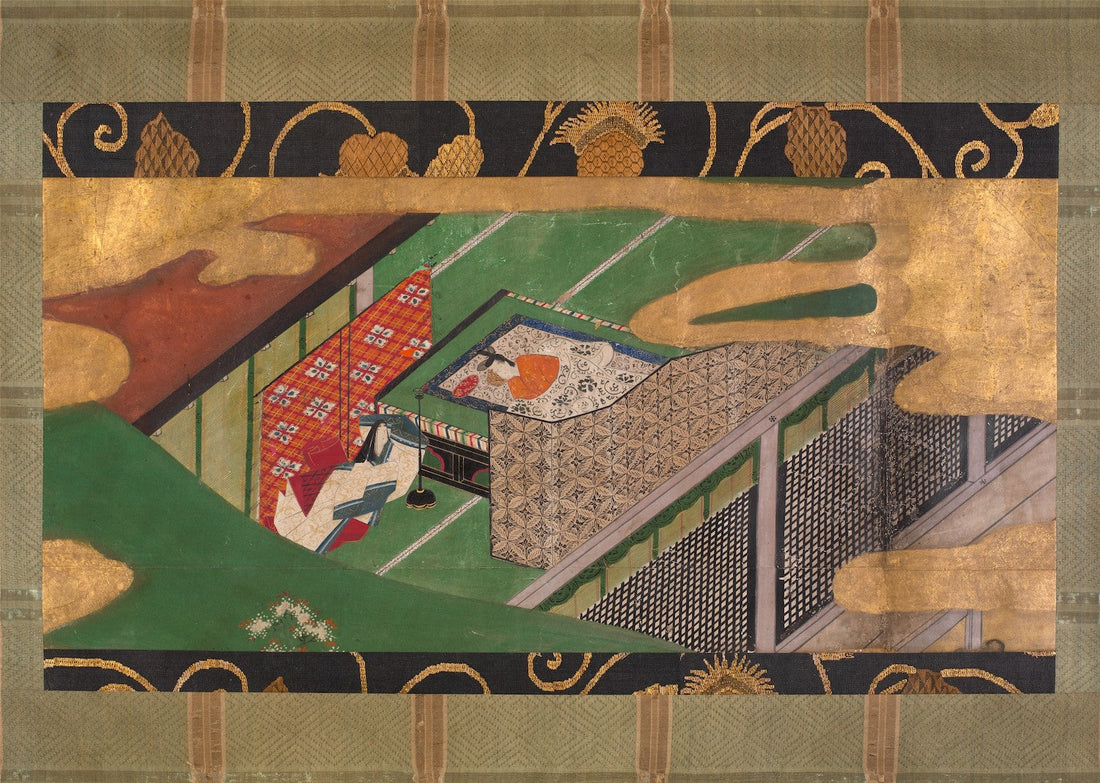Feature image: 伝俵屋宗達筆_源氏物語図「宿木」; Scene from The Ivy (Yadorigi), chapter 49 of The Tale of the Genji, via The MET
Ukiyo-e and Kabuki
Early Japanese artworks were often highly influenced by Chinese styles and customs. By the late 9th century, Japan had ceased official trade with China and had begun to focus more on itself. During this time, a new art form called yamato-e, was created. Unlike previous art styles, which often featured Chinese themes, Yamato-e focused entirely on Japanese places, people, and customs. It was a style of the elite and was often used to decorate sliding doors and folding screens. Yamato-e’s distinct style features bright pigments and large bands of clouds and often removes the roof of buildings to present an aerial view of the interior. Yamato-e evolved over the years by embracing portraiture and appealing to middle-class individuals. Its distinctly Japanese themes deeply influenced other painting styles that emerged, including the popular woodblock prints ukiyo-e.
Like Yamato-e, ukiyo-e focused on Japanese places, people, and customs but did so through a contemporary lens. Ukiyo-e was particularly popular during the Edo period (1615-1868). It is a form of printmaking where the artist carves their design into a woodblock, applies the ink, and creates their print. The word itself translates to the floating world, which is featured by ukiyo-e’s use of aerial perspectives, precise details, and flat color. This form of Japanese art was the first to find its way to Europe and America. The works of ukiyo-e influenced many Western artists and movements, such as Impressionism, Art Nouveau, and Modernism. Initially, the colors in ukiyo-e were not printed but applied with a brush. It wasn’t until the mid-18th century that colored inks were applied directly to the woodblock, but the colors were limited to a few colors. It wasn’t until 1765 that Suzuki Horunobu invented the Nishiki-e process, which allowed prints to be made with a full range of colors. Subjects of Ukiyo-e were often taken from upper-class lifestyles and activities. This included sumo wrestlers, geishas , warriors from folklore, and actors from kabuki theater.
Kabuki is a type of Japanese theater that began in the 16th century. Typical kabuki lasts for many hours and features elaborate costumes, stylized poses, singing, dancing, and a great deal of action. Kabuki actors speak in monotone voices and perform using specific acting styles, such as mie. The music and sound effects used in kabuki are created using shamisen, flutes, drums, bells, and clappers. Initially, kabuki was performed by both men and women, but the Japanese government felt this form of entertainment was too sensuous as often the actresses were also prostitutes. This led to a ban on women from performing kabuki in 1629. Young boys took on the roles denied to women, but there continued to be moral concerns. This time surrounding the use of young children. This led to the art form being taken over entirely by adult men, a tradition that has held fast to the modern day. Kabuki plays are about historical events and often speak to tragedy, moral conflict, and human passion. Some of the most popular traditional kabuki plays include “Yoshitsune and the Thousand Cherry Trees,” “Kanadehon Chushingura,” and “Benten Kozo.”
Shibai Ukie, Okumura Masanobu (c.1741)
Okumura Masanobu uses ukiyo-e to depict the appearance of the kabuki theater in its early days. To the left of the image, viewers can see the hanamachi, a classic element of kabuki theater, which is a runway that juts out from the stage and into the audience. The hanamachi is often used for climactic scenes such as battles or processions as well as in intimate scenes where the actor can connect with the audience through emotion. These runways were also often equipped with a trapdoor, much like the main stage, that allowed actors to appear and disappear with ease suddenly.
Kabuki Actor Otani Oniji III as Yakko Edobei, Toshusai Sharaku (1794)
This is one of the most recognizable ukiyo-e works that depicts a Kabuki scene. The character portrayed here is the ruthless manservant Otani Oniji III from “The Colored Reins of a Loving Wife.” This moment depicts the character in a moment of mie; his exaggerated emotion and splayed, outstretched hands capture the dramatic nature of Kabuki. This genre of ukiyo-e was called yakusha-e. Ukiyo-e prints were split into five genres: bijin-ga, shunga, kacho-ga, landscape, and yakusha-e. Bijin-ga prints featured women who were known for their beauty, shunga depicted erotic acts, and kacho-ga highlighted beautiful birds and flowers. The final genre, yakusha-e, focused specifically on prints depicting kabuki actors. They were often inexpensive, kept as souvenirs, and used to promote celebrity actors.
The kabuki actors, Toyohara Kunichika (1868)

Here, Toyohara Kunichika depicts three kabuki actors; starting on the right is Ichimura Kakitsu IV as Asahina Tobei, in the center is Nakamura Shikan IV as Washi no Chokichi, and on the left is Sawamura Tosshi II as Yume no Ichirobei. This print is full of color and action as the actors lunge back, forward, and away from a drawn knife. The details in the actors' tattoos are intricate and speak to the details found in ukiyo-e and kabuki. This work is also an example of the full-color range that the invention of the Nishiki-e process allowed.
Both ukiyo-e and kabuki are still used and celebrated by artists and people alike. They are both intensive art forms that focus on detail and color while also being steeped in long traditions. They are both widely influential art forms that grew from the need for a distinctly Japanese style free from outside influences.
©ArtRKL™️ LLC 2021-2024. All rights reserved. This material may not be published, broadcast, rewritten or redistributed. ArtRKL™️ and its underscore design indicate trademarks of ArtRKL™️ LLC and its subsidiaries.








